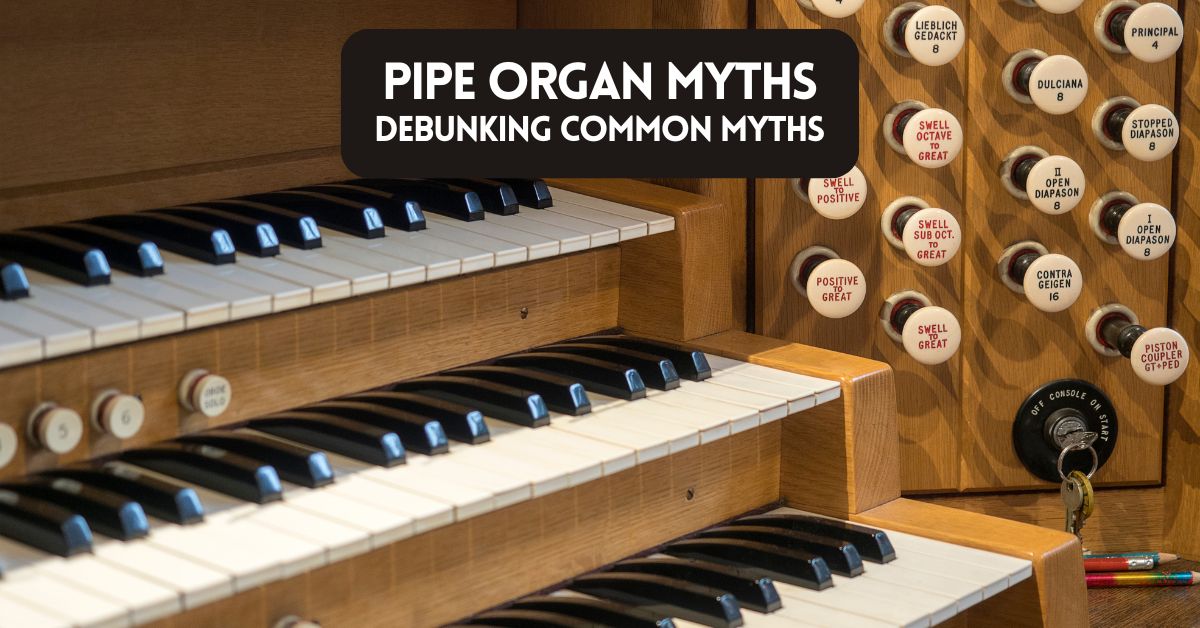The pipe organ is a keyboard instrument steeped in history, grandeur, and mystique. Often found in cathedrals, concert halls, and historic theaters, this remarkable instrument has captivated audiences for centuries. But with such a rich history comes a collection of myths and misconceptions that leave many scratching their heads. In this article, we’re tackling some of the most common myths about the king of instruments.
Azure Hills Music contains affiliate links and is a member of the Amazon Services LLC Associates Program. As an Amazon Associate, we earn from qualifying purchases at no extra cost to you when you purchase using one of these Amazon links. Read our disclaimer and privacy policy for more information.
Debunking Common Myths About the Pipe Organ
The pipe organ’s complexity and prestige often lead to misunderstandings about how it works and what it’s capable of. While some of these myths may come from pop culture depictions or assumptions, others result from a lack of firsthand experience. Let’s separate fact from fiction!
Myth 1: Pulling organ stops is like using Hammond’s drawbars
One of the most pervasive misconceptions about the pipe organ is the idea that organ stops behave like the drawbars on a Hammond organ, which can be gradually adjusted to mix tones. While drawbars allow a gradual, sliding control over sound and volume, pipe organ stops function quite differently.
Organ stops are binary by design; they’re either engaged (on) or disengaged (off). When you pull a stop, you’re quite literally opening the “voice” of a particular set of pipes and allowing air to flow through them. There’s no gradual blending here! This binary functionality gives the organ its ability to transition quickly between sounds, achieving its powerful dynamic range.
Myth 2: Playing the pipe organ is just like playing a piano
At first glance, you might assume that playing a pipe organ is simply like sitting at a larger-than-life piano. After all, there are keys involved! But in reality, playing the organ is an entirely different beast.
For starters, most pipe organs include not just one, but multiple keyboards (known as manuals), as well as a set of pedals to control the bass notes. This means organists need both their hands and feet to play, often performing intricate choreography across the instrument. Additionally, the organ doesn’t naturally sustain notes like a piano does, so organists must use their skill to create seamless legato effects or dramatic staccatos.
Myth 3: The bigger the organ, the louder the sound
The size of a pipe organ is undeniably impressive, with massive installations featuring thousands of pipes housed in grand structures. However, a large organ doesn’t necessarily equate to overwhelming volume. The perceived loudness of an organ primarily depends on the space in which it resides and the selection of stops the organist uses. Some of the largest pipe organs are also capable of producing a delicate whisper, with soft stops designed for gentle accompaniment or meditative moments.
It’s also worth noting that many pipe organs are meticulously voiced to suit their environment. An organ built for a small chapel won’t sound the same as one built for an echoing cathedral, even if the stop lists are identical.
Myth 4: Pipe organs are only for religious music
Many associate the sound of the pipe organ with church services, and while it’s certainly an integral part of liturgical music, the organ’s versatility extends far beyond the walls of religious spaces. From thrilling symphonies by composers such as Camille Saint-Saëns to cinematic scores for films like Interstellar, the pipe organ has proven its adaptability time and again. Organists frequently perform complex classical pieces, transcriptions of orchestral works, and even pop or rock tunes. The possibilities are nearly endless!
You’ll hear a pipe organ as the centerpiece in my track Music of the Spheres – inspired by the Edgar Allan Poe poem, The Conqueror Worm
Myth 5: Pipe organs are outdated and irrelevant today
The pipe organ may have been invented centuries ago, but it remains a living, breathing (quite literally!) instrument with a dynamic place in modern music. Many contemporary composers continue to write for the organ, blending it into new genres and experimenting with its vast tonal palette. Beyond concert halls, digital organs and hybrid instruments are making the pipe organ more accessible to smaller spaces and modern music-makers. Far from outdated, the pipe organ continues to inspire fresh creativity across the musical spectrum.
Myth: 6 Pipe organs are unbearably difficult to maintain
Maintaining a pipe organ indeed requires specialized knowledge, but it’s far from impossible. Organ builders and technicians around the world dedicate their expertise to keeping these magnificent instruments in top shape. Routine tuning and cleaning, coupled with adjustments to the pipes and mechanisms, ensure longevity and consistent sound. Well-maintained pipe organs can last for centuries, passing their legacy from one generation to the next.
Myth 7: All pipe organs sound the same
The sound of a pipe organ is deeply influenced by numerous factors, including its size, design, and the creative vision of its builders. French organs are celebrated for their bold and romantic tones, German baroque organs for their precise and rhythmic quality, and English organs for their rich and balanced sound. The acoustic properties of the space they inhabit also shape their character. This incredible diversity across organs worldwide makes every pipe organ a unique listening experience.
I’ll take this one step further. In the modern keyboard era, especially on sample-based instruments known as romplers, it’s common to find one or more sounds labeled pipe organ. More often than not, these sound offerings are either a single flute stop or come from the other end of the spectrum of tutti, where nearly all stops are pulled. These instruments miss the vast nuance available from the otherwise dozens or hundreds of combinations available when sitting at a real pipe organ.
Myth 8: The Hammond Organ sounds much like a pipe organ
The Hammond organ, often mistaken for its similarity to a pipe organ, has its own unique sound characteristics that set it apart. Unlike a pipe organ that utilizes air flowing through pipes to produce sound, the Hammond organ generates tones electronically through mechanical tonewheels. This results in a distinct, vibrant sound that is rich in vibrato and tremolo effects, especially when connected to a Leslie speaker.
Modern digital Hammond organs, such as the Hammond XK5, have pipe organ samples available as part of their sound bank.
The pipe organ’s tones are more diverse, with sounds from four families – principal stops, flute stops, string stops, and reed stops.
Bringing the Mystique of the Pipe Organ to Life
The pipe organ is so much more than the myths surrounding it. It’s an instrument of unparalleled versatility, a marvel of engineering, and a testament to human creativity and craftsmanship. Whether you’re hearing its powerful notes reverberate through a grand cathedral or enjoying a solo recital in a modern concert hall, the pipe organ has a timeless ability to inspire awe.
If today’s glimpse into the world of the pipe organ has sparked your curiosity, consider exploring a local organ concert or reaching out to an organist to learn more. You don’t have to be a musician to appreciate the magic and majesty of this one-of-a-kind instrument. And who knows? Your next adventure may just begin with the pull of a stop.
Thanks for reading this article!
Arthur Dobrucki


